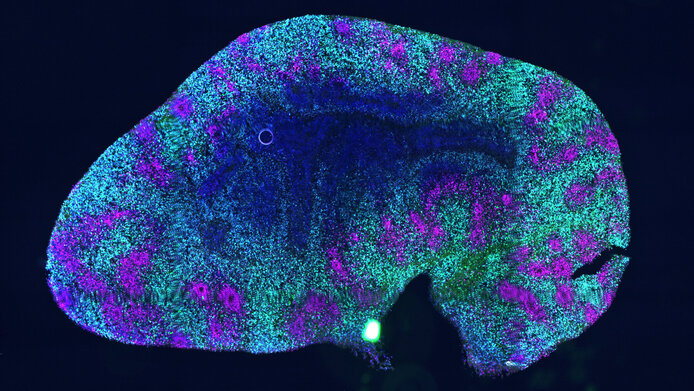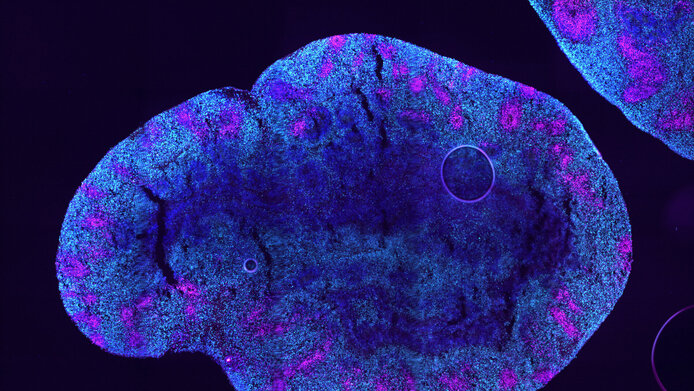A molecular fountain of youth for the brain

As we get older, our brain ages along with us: we find learning new things more difficult and our memory occasionally fails us. But sometimes the symptoms may be less harmless. Ageing is a risk factor for neurodegenerative diseases – such as Parkinson's and Alzheimer's – in which nerve cells die off particularly quickly and in large numbers. Important brain functions are irretrievably lost, because, unlike skin cells, the body cannot replace neurons once they have died.
Hence, researchers around the world are looking for interventions that slow down brain ageing or mitigate its consequences. But we still have a long way to go, says Frank Edenhofer, head of the Genomics, Stem Cell Biology and Regenerative Medicine research group at the University of Innsbruck: “The molecular processes that play a role in neuronal ageing are still largely unknown. Only when we understand these processes better will it be possible to develop therapies that counteract the causes of Alzheimer's and the like.”
Ageing processes in the “mini-brain”
On their way to this goal, the stem cell researcher and his team have achieved an important success: the group succeeded in demonstrating typical ageing processes in so-called brain organoids. These are 3D miniature brains that come closer to the structure of the human brain than mouse brains and 2D cell cultures. For the first time, the researchers have a human tissue model that enables them to watch the ageing of the brain.
“We see typical degenerative processes: oxidative and other age-related damage to the DNA as well as reduced mitochondrial activity,” notes Edenhofer, and he mentions the remarkable “epigenetic erosion”. “Epigenetic markers give cells their identity. We have seen that these marks are gradually lost. As a result, the affected neurons 'forget' what they are and stop functioning.” This observation highlights the importance of epigenetic changes in the context of ageing.
Fountain of youth for nerve cells
Can brain aging be delayed or even reversed? A research group led by stem cell researcher Frank Edenhofer at the University of Innsbruck has successfully observed aging processes in mini-brains (organoids) made from human tissue. Reprogramming old neurons into young ones is the researchers’ next step.
Reward for a creative research approach
The research team recently submitted the promising results for publication – a first reward for overcoming numerous challenges: “Getting the organoids to age was difficult. Given that they are generated from stem cells, they are in a 'young' development program,” explains Frank Edenhofer. “We therefore had to force the cells to express a protein called progerin, which induces ageing. This required many attempts.” In humans, progerin triggers Hutchinson-Gilford syndrome, which leads to extremely premature ageing.
The researchers’ efforts have paid off: once established, the organoid model is now the starting point for follow-up studies that will improve our understanding of neuronal ageing. The team hopes to identify new genes that play a role in this process. Some indications of this were already found in the profile of the organoids' gene activities: “We see some unexpected genes that have not yet been described in the context of brain ageing,” says Edenhofer.

The objective: rejuvenation for the brain
Edenhofer is also exploring a “hot topic” in longevity research: “If we can artificially age cells, can we also rejuvenate them?” This addresses the idea of resetting the developmental program of cells: old, differentiated neurons would thus be reprogrammed into brain stem cells, thereby enabling the brain tissue to auto-renew. The research team is now taking the first steps towards this major goal, as Edenhofer reports: “We are using a gene cocktail that we know can reprogram cells in mice. We have found initial indications that this 'rejuvenation cocktail' reverses the epigenetic erosion of neurons.”
Edenhofer believes it will be a long time before there is a rejuvenation cure for the brain in the form of a medication. He is critical of the idea of treating ageing as a disease: “There is a big difference between normal and pathological signs of ageing.” One of the research group’s goals is to cure the latter, but also to delay normal ageing through targeted preventive measures. “Perhaps one day it will be possible to specifically support prevention with medication. Our research helps us to understand how our daily behavior – such as diet and exercise – influences epigenetics and mitochondrial fitness.” For the time being, the best “fountain of youth” remains an active lifestyle – in order to make our brain age as healthily as possible.
Personal details
Frank Edenhofer is Professor of Genomics and Deputy Director of the Institute of Molecular Biology at the University of Innsbruck. His research group investigates the molecular basis of diseases, with a focus on stem cell research and cellular reprogramming to enable new regenerative therapies. In 2012, his group at the University of Bonn succeeded in producing neural stem cells from skin cells for the first time. Set to run until 2025, the project A Fountain of Youth for the Brain receives funding from the Austrian Science Fund FWF under its 1000 Ideas Program which supports innovative projects with high transformative potential.
Publications (selection)
Spathopoulou A., Podlesnic M., De Gaetano L. et al.: Single-cell Profiling of Reprogrammed Human Neural Stem Cells Unveils High Similarity to Neural Progenitors in the Developing Central Nervous System, in: Stem Cell Reviews and Reports 2024
Beirute-Herrera J., López-Amo Calvo B., Edenhofer F., Esk Ch.: The promise of genetic screens in human in vitro brain models, in: Biological Chemistry 2024





